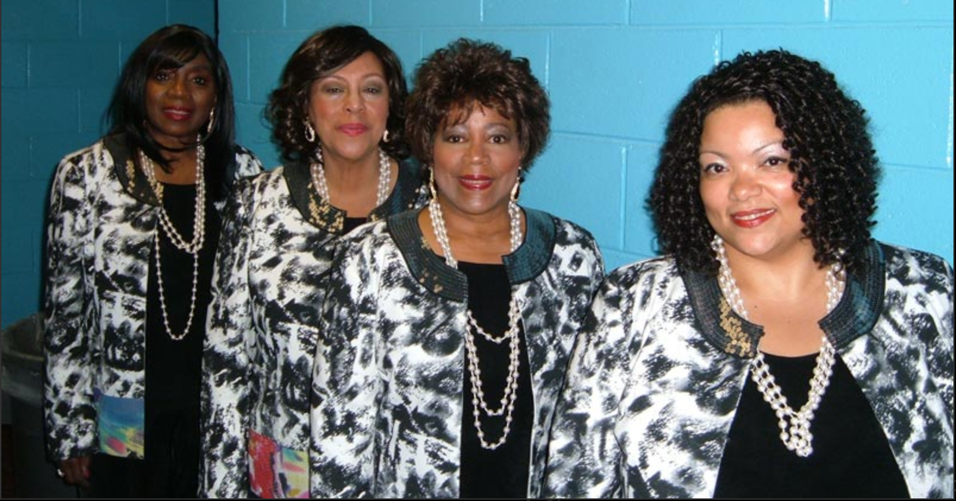The Scoop Talks to Lois Powell of The Chantels
 Lois pictured second from Right
Lois pictured second from Right
Until she was 14 years old, original Chantels member Lois Powell (née Harris) knew nothing of the new sounds of rhythm & blues which were grabbing the attention of teens across America. “We only listened to classical music in my house,” she says. “And, if we did listen to anything else, then it was Make Believe Ballroom” (hosted by groundbreaking disc jockey Martin Block, who spun the pop hits of the day: no blues, country or R&B allowed).
“At St. Anthony’s of Padua our choir was very active. Our choir was all girls so it was soprano, soprano, alto, alto. I sang soprano. We did the liturgical music of the church, mostly in Latin, and won national competitions. We didn’t know anything about gospel music. We knew about spirituals, but we were not singing them the way they should have been sung. It was always very sweet and very pretty.”
“My older cousin Joan listened to the music on the black stations. My cousins had birthday parties and the kids would dance at them, and [that’s where] I started to hear a different kind of music.”
“One of the first records that I heard was ‘Gee’ by The Crows (1954). Then, it was The Chords’ ‘Sh-Boom’ (also 1954). And I said, ‘Oh, this is interesting.’”
“The boys started singing on the corners in our part of The Bronx, and we said, ‘Why can’t we do that? They’re not the only ones who know how to sing!’”
“We” were five local girls. “Arlene Smith wanted to get a group together to do [what] the guys were doing,” says Lois. “Girls came and girls went until Arlene found the right blend of voices with Jackie Landry, Sonia Goring, and Renee Minus. “At some point, I was asked to join them and we started doing their neighborhood contests at the public schools, like PS 23.”
“Sonia, Renee, Arlene, and Jackie were on the basketball team, and used to play the St. Jane Frances de Chantal team. They were trying to think of a name: something like Chantal [pronounced Shawn-Tall) because they were picking up on the name of that school. I said, ‘Well, in French a female singer is a chanteuse and singing in Latin is chant,’ so we kind of played around with that all together and came up with ‘Chantels.’”
“But…it was pronounced Shawn-tells. We wanted it to be more French, more sophisticated, but nobody pronounced it that way! Over the years, the ‘a’ flattened out and it became The Shan-tells.”
“We sang some of the stuff that we heard the boys on the corner doing, but we made up our own words and we changed the harmonies. Mostly we ended up doing slow, romantic things. Not that we knew anything about romance!”
Their big break came when the five bumped into songwriter/producer/singer Richard Barrett, who sang lead for The Valentines (“Lily Maebelle,” “The Woo Woo Train”) and discovered Frankie Lymon and The Teenagers.
“We were dressed alike and we were going downtown to a show. We knew that The Valentines were on that particular show and we wanted to meet anybody that we could.”
In front of the now-legendary Brill Building (1619 Broadway), a guy coaxed them inside with “promises” of recording stardom. While he played a piano, Lois happened to look out the second story window and spotted three of The Valentines passing by. The girls yelled to them and — says Lois — “Richard signaled, ‘Come down’” and off they went.
“Richard said, ‘Are you sisters?’ And we said, ‘No, we sing.’ And he says, ‘Oh, really?’ We said, ‘Yes, and we sing pretty well!’”
“He said, ‘OK. Let me hear something.’ And whatever it was we sang, he was impressed, and he said, ‘I can probably do something.’ And we said, ‘Yeah. Sure.’”
“It felt like months went by before we heard from him, but it was probably only weeks.” Richard promptly began rehearsing the girls in preparation for their audition with George Goldner of End Records for whom Barrett worked as an A&R man.
Barrett also reworked some of Arlene’s original songs. “He changed the melodies and wrote other lyrics,” Lois recalls. “Basically, Richard wrote ‘He’s Gone’ and ‘Maybe.’ Arlene wrote most of ‘The Plea’ and Richard spiced it up a little bit.”
Released in August 1957, “He’s Gone” b/w “The Plea” (End 1001) made enough radio noise to land the A-side in the lower reaches of Billboard magazine’s Top 100, which led to their big public debut at one of pioneer rock ’n’ roll deejay Jocko Henderson’s Apollo Theater shows.
“We were very nervous,” says Lois. “We knew the history of the Apollo and we didn’t want to get booed off the stage, but they liked us.”
Their second recording session in October yielded “Maybe,” an ordeal Lois remembers well. “There were no [pre-recorded instrumental] tracks like there are today. Everybody was there.”
“‘He’s Gone’ and ‘The Plea’ hadn’t taken that long. It was ‘Maybe’ that drove me nuts. We had to record it 52 times, until Richard got Arlene [so] frustrated she was pretty much crying. That’s what he wanted and that was the final take.”
Asked about reports that “Maybe” was recorded in a church, Lois is adamant: “No, no, no, and no! They just put some reverb on it in the studio.”
“Maybe” peaked at #15 on the Top 100 in early 1958 and reached #2 on the Billboard and Cash Box R&B lists. “Maybe” was still in the national Top 30, when The Chantels’ next single “Every Night (I Pray)” debuted on the Top 100, eventually making it to #39 in Billboard (#16 R&B) and #32 in Cash Box (#6 R&B).
In mid-summer “I Love You So” became the quintet’s final End Records chart entry, topping out at #42 pop and #14 R&B in Billboard.
Between record sales and their public appearances, The Chantels were earning a considerable amount of cash, but where was it going? “All of our money [went into] an account they had for us,” says Lois, “and we got an allowance of 20 dollars a week. Out of that allowance Richard bought faux fur coats for us and he bought a car to drive us to the venues. Apparently, we paid for that car. A Cadillac!”
Then came the cruelest cut of all. “They called us into a meeting and said that the record company was no longer going to be in existence. And we asked, ‘Where is all the money that you’ve been holding for us?’ And they said, ‘There is none.’”
Lois’s mother gave her an ultimatum: go to school or get a job. “I went to Mandl School (The College of Allied Health) in the city, around the corner from a studio where we rehearsed. After school I would meet the girls, and they’d be recording, but after a while I had to make a choice. So I just pulled out, and the girls continued on.”
Meanwhile, End had released more singles, and continued to issue Chantels tracks from its existing backlog of Chantels tracks, even after Arlene Smith had moved on as a solo artist, and the three remaining members — plus new lead singer Annette Smith (no relation) — had scored the group’s biggest Hot 100 hit: the #6 “Look In My Eyes” on Carlton Records in the fall of 1961.
The years went on and the “girls” kept on singing. Lois became a psychiatric nurse, ultimately earning a master’s degree from Columbia University. In 1995 The Chantels reunited for their induction into the U.G.H.A Hall of Fame and received a pioneer award from the Rhythm & Blues Foundation in 1996.
With The Chantels back in the limelight and in demand, Lois, Sonia, Renee, and new lead singer Ami Ortiz (sadly Jackie passed away in 1997) hit the stage once again with their breathtaking vocal blend.
Over the years, the individual Chantels enjoyed a successful career apart from music. “Each of us had something to contribute, all because we sang. It kept us grounded.” Lois “directed a high school-based program for psych rehabilitation to keep kids from being hospitalized or re-hospitalized. I could give to those kids, and I could give to my community.”
On this year’s Malt Shop Memories cruise, Lois and The Chantels will give us the gift of their angelic voices. “It sounds really, really exciting. We like to be where people appreciate that music. That makes us sing even better. It makes us feel loved and we love back, and the audience will feel it!”
Ed Osborne © 2018
